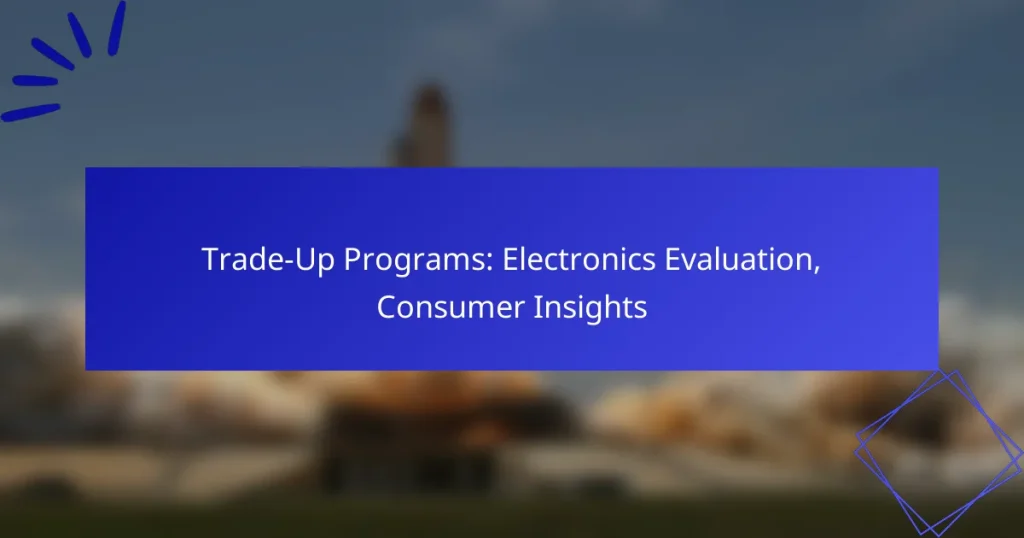
Trade-Up Programs: Electronics Evaluation, Consumer Insights
Trade-up programs in electronics provide consumers with an opportunity to exchange their old devices for…
Trade-up programs provide consumers with an opportunity to maximize the value of their old products by exchanging them for credit towards newer models. This not only helps reduce the financial burden of upgrading to the latest technology but also promotes responsible recycling and refurbishment of older devices.
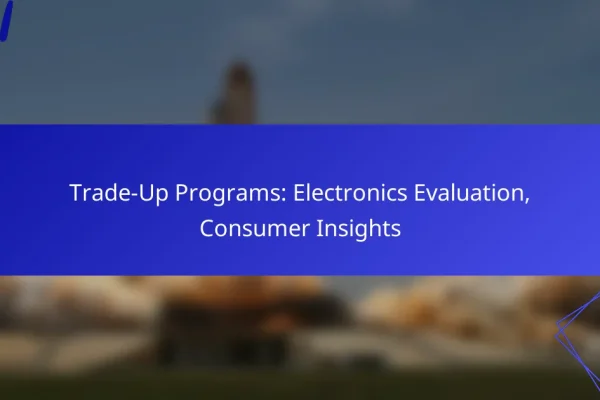
Trade-up programs in electronics provide consumers with an opportunity to exchange their old devices for credit towards new purchases, making upgrades more affordable. These programs assess the condition and market value of traded-in electronics, ensuring that consumers receive a fair trade-in value that can significantly reduce the cost of their new devices. How do trade-up…
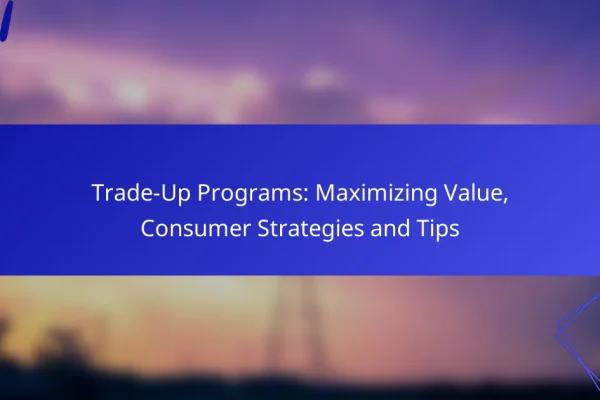
Trade-up programs present an excellent opportunity for consumers to enhance their value by offering competitive trade-in prices for older products, making it easier to access the latest models while fostering brand loyalty. By understanding the terms of these programs and timing your trade-in effectively, you can maximize your return on investment and minimize out-of-pocket expenses….
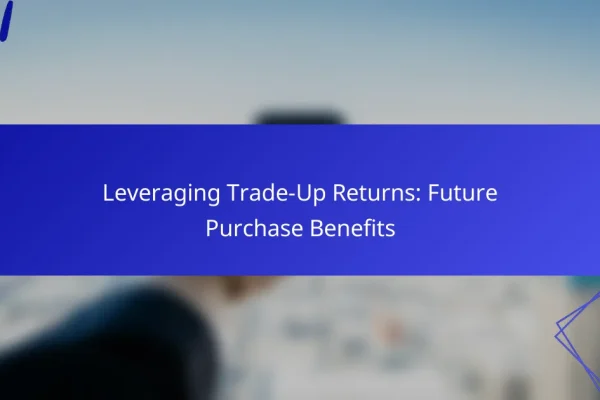
Leveraging trade-up returns can significantly enhance future purchases by offering customers valuable incentives and credits for returning old products. This practice not only makes upgrades more affordable but also fosters customer loyalty and encourages repeat business, ultimately benefiting both consumers and retailers alike. How can trade-up returns enhance future purchases? Trade-up returns can significantly enhance…

Trade-up programs provide consumers with the opportunity to exchange their old products for credit towards new purchases, making upgrades more affordable. However, these programs often come with specific restrictions that can influence your eligibility and the value of your trade-in. Understanding the terms and conditions is essential to maximize the benefits and avoid potential pitfalls…
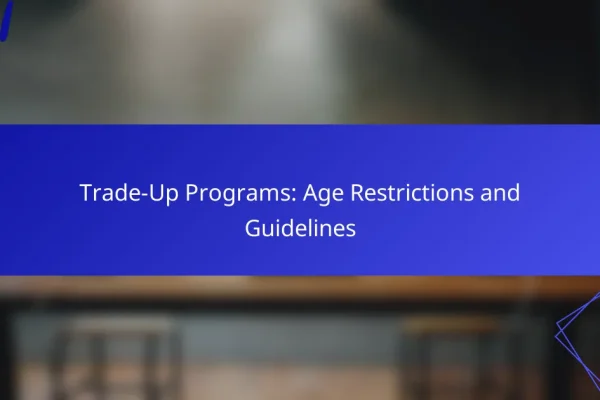
Trade-up programs offer consumers the opportunity to exchange old devices for credit towards new purchases, but they often come with specific age restrictions and guidelines. Most providers require participants to be at least 18 years old, although some may permit younger individuals to join with parental consent. Adhering to established guidelines is essential for determining…

In today’s competitive e-commerce landscape, businesses can significantly boost trade-up returns by adopting strategic marketing practices and enhancing customer loyalty. Current market trends highlight a growing emphasis on sustainability, subscription models, and personalized shopping experiences, reflecting evolving consumer preferences. Industries such as consumer electronics, fashion, and home improvement are particularly well-positioned to capitalize on these…

Trade-up shipping offers consumers a range of options that can impact both costs and delivery times. By understanding the various elements such as base shipping fees, handling charges, and insurance costs, consumers can better manage their shipping expenses. Additionally, being aware of handling considerations, including packaging requirements and weight limits, is essential for ensuring a…

Trade-up items must meet specific condition requirements that vary by category, ensuring they are functional and free from significant damage. Understanding the standards for each category is essential for determining whether an item is acceptable for trade-up programs, as well as assessing its market demand, condition, and rarity to make informed trading decisions. What are…
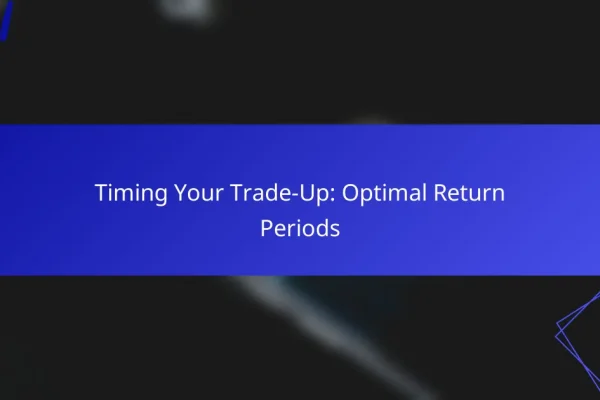
Timing your trade-up in electronics is crucial for maximizing returns, as optimal return periods vary by device type and market conditions. By understanding seasonal demand and key factors such as device condition and brand reputation, you can strategically plan your exchanges to achieve the best value. This knowledge allows you to minimize losses and capitalize…

Maximizing trade-in value is essential for consumers looking to upgrade their devices while minimizing costs. By understanding market trends, comparing offers, and ensuring their devices are in optimal condition, consumers can significantly increase their returns. Key factors such as device condition, brand reputation, and market demand play a crucial role in determining trade-in value. How…
Trade-up programs maximize value for consumers by allowing them to exchange their old products for credit towards newer models. This process not only enhances the financial return on older items but also facilitates access to the latest technology and features.
Trade-up programs often provide higher trade-in values compared to selling items independently. Retailers assess the condition and market demand for devices, enabling consumers to receive competitive offers. For example, a smartphone that might sell for around $200 privately could yield $250 or more through a trade-up program.
Participating in a trade-up program gives consumers immediate access to the latest models without the need for significant upfront investment. By trading in an older device, consumers can often acquire a new model at a reduced price. This is particularly beneficial in technology sectors where advancements occur rapidly.
Trade-up programs can lead to substantial cost savings when upgrading to newer products. The credit received from trading in an old item can offset the purchase price of a new one, making upgrades more affordable. For instance, if a new laptop costs $1,000 and the trade-in value of an old one is $300, the effective cost drops to $700.
Using trade-up programs contributes positively to environmental sustainability by promoting recycling and reducing electronic waste. Many programs ensure that traded-in devices are refurbished or recycled responsibly, minimizing their impact on landfills. This approach aligns with growing consumer awareness of environmental issues.
Engaging in trade-up programs can foster greater customer loyalty as consumers appreciate the value and convenience offered. Companies that provide these programs often build stronger relationships with their customers, encouraging repeat business. Loyalty can be further enhanced through incentives such as discounts on future purchases or exclusive offers for program participants.
The best trade-up programs in the US offer consumers a way to exchange old devices for credit towards new purchases. These programs can significantly reduce the cost of upgrading to the latest technology while ensuring that older devices are recycled or refurbished responsibly.
The Apple Trade In Program allows customers to trade in their old Apple devices for credit towards new purchases. Depending on the device's condition and model, users can receive credit ranging from a few dollars to several hundred dollars.
To participate, customers can visit an Apple Store or use the online trade-in tool. It's essential to ensure that the device is in good working condition to maximize the trade-in value. Apple provides a straightforward process, including free shipping for online trades.
The Samsung Upgrade Program enables customers to trade in their old devices when purchasing a new Samsung smartphone. This program typically offers a fixed trade-in value, which can be applied directly to the purchase price of the new device.
Participants must sign up for a financing plan, and they can upgrade to a new device after a specified period, usually around 12 months. It's advisable to check the eligibility of the old device and understand the terms of the financing agreement before committing.
Best Buy's Trade-In Program allows customers to trade in a variety of electronics, including smartphones, tablets, and laptops, for store credit. The value of the trade-in is assessed based on the item's condition and model.
To initiate a trade, customers can visit a Best Buy store or use the online trade-in estimator. It's beneficial to compare the trade-in value with other programs, as Best Buy may offer competitive rates, especially during promotional events.
The Amazon Trade-In Program offers customers the opportunity to trade in eligible electronics for Amazon gift cards. This program covers a wide range of items, including smartphones, tablets, and video games.
To participate, users can search for their device on the Amazon Trade-In page, receive an estimated value, and ship the item for free. It's important to note that the final value may vary based on the device's condition upon inspection. Users should consider this program for quick and easy credit towards future purchases on Amazon.
Trade-up programs allow consumers to exchange their old devices for credit towards a new purchase. These programs typically assess the value of the current device, facilitate the trade-in process, and provide discounts or credits that can be applied to new products.
The assessment of your current device is a crucial first step in a trade-up program. Companies often evaluate the device's condition, age, and market demand to determine its trade-in value. Common factors include physical damage, functionality, and whether the device is still supported by the manufacturer.
To maximize your trade-in value, ensure your device is clean and in good working order. Minor repairs, such as replacing a cracked screen or cleaning ports, can significantly enhance the offer you receive.
The trade-in process generally involves several straightforward steps. First, you will need to provide details about your device, including its model and condition, either online or in-store. Next, you will receive an estimated trade-in value based on your input.
Once you agree to the trade-in value, you will typically send your device to the retailer or bring it to a store location. After inspection, the final value will be confirmed, and any necessary adjustments will be made based on the actual condition of the device.
After the trade-in process is complete, you will receive credit or discounts that can be applied to your new purchase. This credit can often be used immediately, either as a reduction in the price of a new device or as a gift card for future use.
Be aware that some programs may have specific terms regarding how and when you can use your trade-in credit. Always read the fine print to understand any expiration dates or limitations on the discounts offered.
Consumers should evaluate several key criteria when selecting a Trade-Up Program, including device compatibility, trade-in value estimation, and the program's terms and conditions. These factors will help ensure that the program meets their needs and maximizes the value of their trade-in.
Device compatibility is crucial when choosing a Trade-Up Program. Ensure that the program accepts your specific device model and condition, as not all programs will take every type of device. For example, some programs may only accept recent smartphone models while excluding older or less popular devices.
Check if the program has restrictions on brands or operating systems. If you are trading in a device that is not widely used, you may find fewer options available, which could impact the trade-in value you receive.
Understanding how trade-in value is estimated can significantly affect your decision. Most programs provide an online tool to assess the value of your device based on its condition, age, and model. This estimation can vary widely, so it's wise to compare values across different programs.
Keep in mind that the final trade-in value may be lower than the initial estimate due to factors like device wear and tear. To maximize your trade-in value, ensure your device is clean and in good working condition before submitting it.
Thoroughly reviewing the terms and conditions of a Trade-Up Program is essential. Look for details on how long the trade-in process takes, any fees involved, and the payment method for your trade-in value. Some programs may offer instant credit, while others might take several weeks to process.
Additionally, check for any restrictions on how the trade-in value can be used. For instance, some programs may only allow the value to be applied toward specific products or services, which could limit your options. Understanding these terms can help you avoid surprises later on.
Many people misunderstand Trade-Up Programs, believing they are straightforward but often filled with myths. Addressing these misconceptions can help consumers make informed decisions and maximize their value.
One common misconception is that trade-in values are set in stone. In reality, these values can fluctuate based on market demand, device condition, and the specific program's terms. It’s advisable to check multiple sources to get a better idea of potential trade-in offers.
For instance, a smartphone's trade-in value may vary significantly between retailers or manufacturers. Regularly reviewing offers can help you identify the best time to trade in your device for maximum return.
Another myth is that only outdated devices are eligible for trade-in. Many programs accept a wide range of devices, including relatively new models. Even devices that are just a year or two old can still hold significant value.
To ensure your device qualifies, check the specific requirements of the trade-up program. Some programs may even offer better incentives for newer models, making it worthwhile to explore your options.
Many consumers believe that Trade-Up Programs are overly complex and difficult to navigate. While there may be multiple steps involved, most programs are designed to be user-friendly. Clear instructions and online tools often simplify the process.
To make the most of these programs, take the time to read the guidelines and FAQs provided by the program. Additionally, consider reaching out to customer support for any clarifications, ensuring a smoother experience.